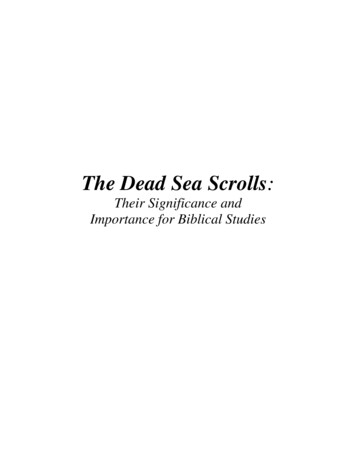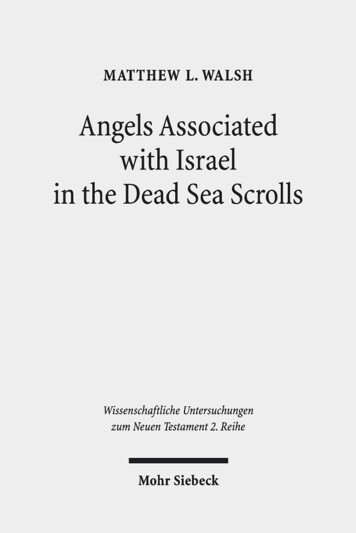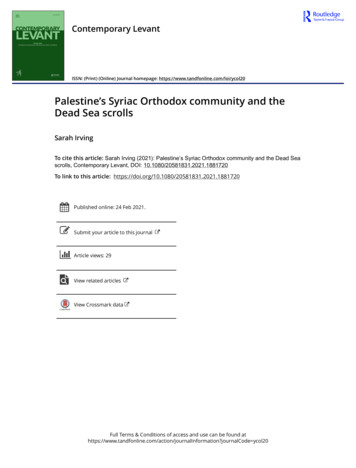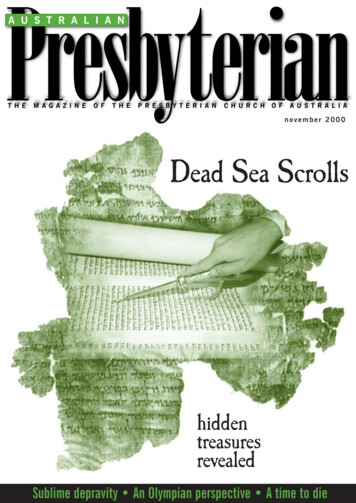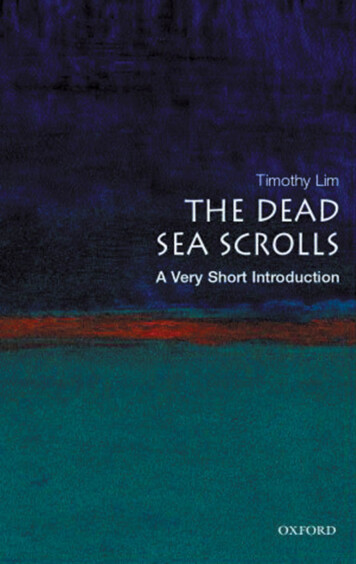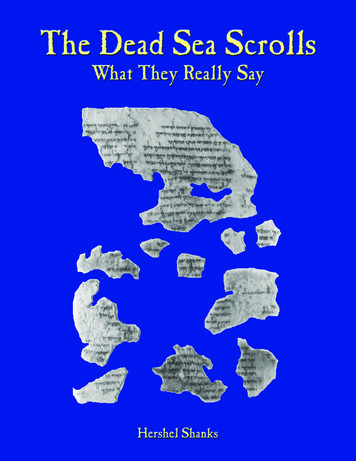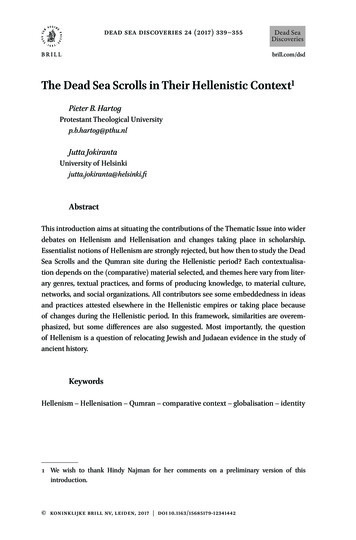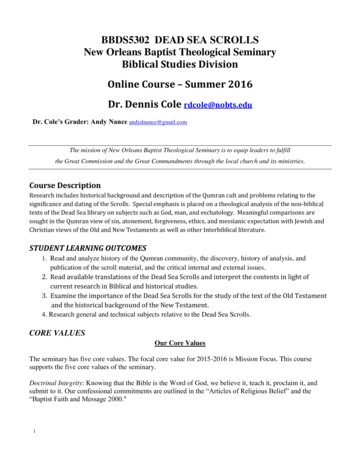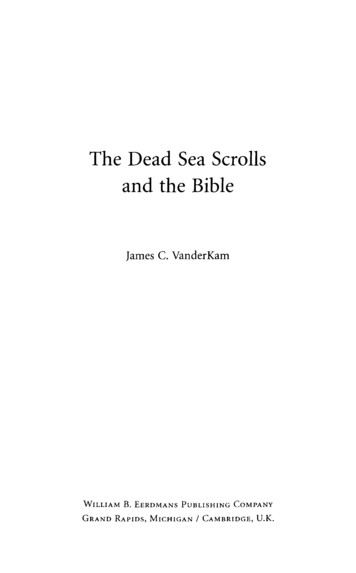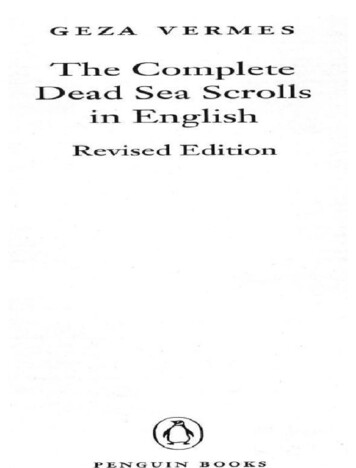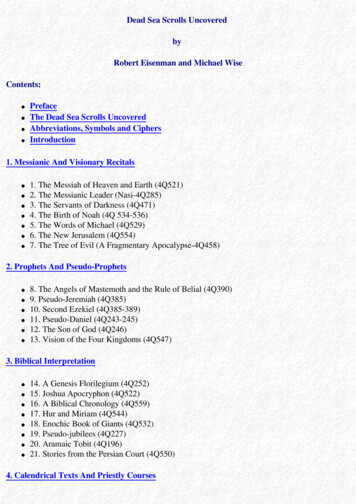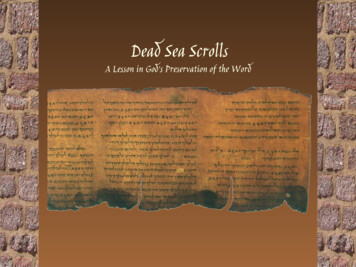
Transcription
Dead Sea ScrollsA Lesson in God’s Preservation of the Word
Matthew 24:35Heaven and earth will disappear, butmy words will never disappearJohn 10:35 the Scripture cannot be broken
Hebrews 4:12For the word of God is living and active, andsharper than any two-edged sword, piercing evento the division of the soul and the spirit, and ofjoints and marrow, and is a discerner of thethoughts and intents of the heart.
William F. Albright”I repeat that in my opinion you have madethe greatest manuscript discovery of moderntimes certainly the greatest biblicalmanuscript find.What an incredible find!“William F. Albright to John C. Trevor(March 1948)
QumranJerusalemQumranJORDANISRAELEGYPTJerusalem is 15-20 miles North West of Qumran
Discovery of the ScrollsThe Dead Sea Scrolls areancient manuscripts thatwere discovered in 1947in 11 caves among thelimestone cliffs of Qumran,overlooking the Dead Sea.Caves of QumranThe Scrolls wereDead Sea near Qumrandiscovered by a young Arabshepherd boy, Muhammadedh-Dhib, as he searchedfor his lostgoat.
Qumran ExcavationsPere Roland de Vaux, a Dominicanmonk, was the original archaeologistwho conducted excavations atQumran from 1951 through 1956. He posited that a religious sect ofJudaism inhabited Qumran knownas the Essenes He discovered structural remainssuch as aqueducts, ritual puritybaths, dinning rooms, cisterns,meeting halls, scriptorium andevidence of earthquake damagedPere Roland de Vaux From 1994 through 2006 Qumrancontinued to be excavated
Ruins of Qumran - 250 BC – AD 68NORTHWadi QumranScroll CavesCisternStoragePoolDinning HallPottery/KilnsMeeting HallRitual llKitchenDead SeaPOPULATION: 200Massive TowerAqueduct
Qumran ExcavationsThe narrow aqueducts on the right were used tochannel water from the cliffs in the west to the Qumrancommunity to fill there ten ritual baths and cisterns.CisternAqueductView looking southeast from Qumran toward the Dead Sea
Qumran ExcavationsViewing west from Qumran towards the cliffs, there areseveral caves in which thousands of manuscripts andfragments were discovered.Scroll Cave 4
Acquisition of the ScrollsBedouin Shepherdsdelivered seven scrollsfrom cave 1 to KhalilSahin (Kando), a Christianantiquities dealer inBethlehem.Kando Soon after, E.L. Sukenik of Hebrew University acquired three of thescrolls In 1949, the remaining four scrolls were sold to Mar AthanasiusSamuel of the Syrian Jacobite Monastery of St. Mark in Jerusalem,then traveled to America On June 1, 1954, Samuel runs ad in Wall Street Journal offeringfor sale “The Four Dead Sea Scrolls”
Acquisition of the ScrollsSamuel’s advertisementwas brought to theattention of Yigael Yadin,E.L. Sukenik’s son. Yadin, with the help ofD.S. Gottesman,purchased the four scrollsfor approximately 250,0000Yadin The four scrolls were returned to Israel and addedto Sukenik’s three scrolls Currently, the 7 scrolls from cave 1 are housedin the Shrine of the Book in Jerusalem
Shrine of the BookThe shrine was built at the Israel Museum (Jerusalem) to display many of theearly scrolls such as Isaiah A-B, Habakkuk Commentary, Thanksgiving Scroll,Community Rule, War Rule, and the Genesis Apocryphon.
What Scrolls were Found?Overall, 11 caves yieldedover 900 biblical and nonbiblical texts, composedof tens of thousands ofmanuscript fragments.* Over 220 texts of theHebrew Bible exceptthe book of EstherGenesis Fragment The scrolls are written in Aramaic, Hebrew and Greekdating from 250 BC to AD 68 Of these texts, over 400 are apocryphal andpseudepigraphal literature
What Artifacts were Found?Of the remains discovered in the Scriptorium (bottom right) at Qumran, acopper inkpot and stone benches and tables lend evidence to a manuscriptproducing environment.
Scrolls of Cave 1A complete book of Isaiah (A) was discovered, whichnow is the oldest complete manuscript of any book ofthe Bible.Also found were: Incomplete book of Isaiah (B) Habakkuk Commentary Various non-biblical bookssuch as the Thanksgiving Scrolland Manual of Discipline Fragments of Genesis, Leviticus,Deuteronomy, Judges, Samuel,Ezekiel, Psalms and Daniel 2:4where the Hebrew languagePortion of Isaiah A
Isaiah ScrollCC-Art.comIsaiah (1QIsa A) was written in Hebrew on parchment (animskin) dating to 125 BC and is approximately26 feet long.
Scrolls of Cave 2Though cave 2 was not as productive, by 1952 itproduced hundreds of fragments including: Two of Exodus23:38-39 One of Leviticus Four of Numbers Two ofDeuteronomy One of Jeremiah,Job, Psalms Two of Ruth23:40-4424:16-18Fragments of Leviticus 23-24 werepurchased in 2005; originally found nearthe Dead Sea
Though of no biblicalScrolls of Cave 3significance, a uniquediscovery in cave 3 produceda Hebrew text in two rollswritten on copper, known asthe Copper Scroll (3Q15). Text lists 60 sites of buriedtreasure (gold, ingots) inthe area of Judean desert No treasure has been found Too fragile to unroll, it wasX-rayed to discover itscontent, then was cut intostrips
Scrolls of Cave 4Cave 4 produced 100 biblical books and contained more than 50,000fragments. Among them was partial copies/fragments of: Genesis Daniel 7:28 to8:1 (Aramaicchanges to Hebrew) Commentarieson Psalms,Isaiah andNahum40,000 fragmentsfound beneath thefloor of cave 4
MessianicTestimonyDiscovered in cave 4 in 1952,this 1st century BC Hebrewmanuscript (aka “Testimonia”)contains messianic passagesfrom the Hebrew Bible,identifying Him as prophet,priest and king. In orderthey are: Deuteronomy 5:28-29 (Prophet) Deuteronomy 18:18-19 Numbers 24:15-17 (King) Deuteronomy 33:8-11 (Priest) Joshua 6:264Q175
Scrolls of Cave 5-6 Cave5 had producedfragments of up to50 biblical and nonbiblical textsCave 5 in foregroundCave 6 yielded fragments Genesis, Exodus,Daniel,Deuteronomy, Ecclesiastes
Scrolls of Cave 7-10 Cave 7 unearthed Greek fragments (7Q3-18)which may be the earliest portions of nineNew Testament books (Mark 6:52-53) Cave 8 contained fragments of Genesis andPsalms Cave 9 and 10 was unproductive yieldingonly a single ostraca along with leathermaterials used for storing and bundlingscrolls
Scrolls of Cave 11In 1956, a partial copy of Leviticus and an Aramaic Targum of Jobwas found. Including: Partial copy of Psalms (above), including 151st Psalm Scholars now posses nearly 40 canonical Psalms ranging fromPsalm 90 to 150 Two of the three non-biblical Temple Scrolls, the
Reliability: Copy AccuracyHow accurate was the copying process during the 1300year interval?Aleppo CodexMasoretic TextDead Sea ScrollsClosed interval by 1000 years95% identicalto theMasoretic Text125 BC900 AD
The Veritas Torah ManuscriptAD 1500sGenesis - Deuteronomy
Discovery of the Scrolls The Dead Sea Scrolls are ancient manuscripts that were discovered in 1947 in 11 caves among the limestone cliffs of Qumran, overlooking the Dead Sea. The Scrolls were discovered by a young Arab shepherd boy, Muhammad edh-Dhib, as he searched for his lost goat. Caves of Qumran Dead Sea near Qumran
